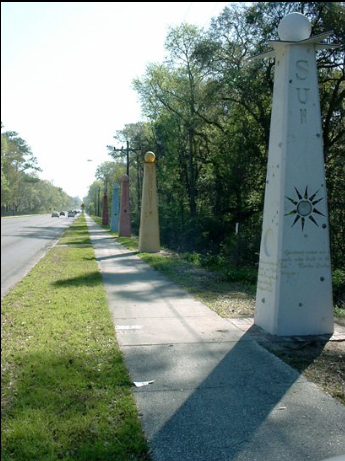Introduction
In
March 2002, artist Elizabeth Indianos*
installed a Gainesville
public art project in cooperation with the
Alachua Astronomy Club, Inc. (AAC) titled
"Gainesville Solar Walk" at a cost of $30,000. The
project was constructed according to proposal
guidelines set up by the Art
in Public Places Trust of the City
of Gainesville, Florida and the AAC.
Since
this time the Art in Public Places Trust (APPT)
- now called Department of Parks, Recreation and
Cultural Affairs - has been cooperatively working
with the Alachua Astronomy Club for additional
enhancements to the site in order to make it an
attraction for Gainesville.
These
enhancements (made in 2006) include: repair and
cleaning of the monuments, design and fabrication of
two benches (see Project Fact Sheet) by Gainesville
Solar Walk artist, Elizabeth Indianos, installation
of two pairs of interpretative signs designed by
Howard L. Cohen of the Alachua Astronomy Club, Inc.
and graphic designer Saydi Kaufman (fabricated by
Crystal Graphics, Inc.), and finally installation of
two donor plaques made by Creative Workshop, Inc.
AAC
member and artist Tim
Malles also designed and created ten
informative bronze plaques that are attached to each
of the planet and Sun scluptures. (More information
on history page.)
Newest
Edition - Comet Halley Sculptures
In September 2008 two Comet Halley sculptures were
added to the Solar Walk (commissioned also by the
City's Art
in Public Places Trust, and designed by the
artist Elizabeth
Indianos with technical help from the AAC):
(1) A Perihelion Sculpture with Tail at the location
of the comet's closest point to the Sun between
Mercury and Venus and (2) an Aphelion Sculpture
without tail at the comet's farthest point from the
Sun about halfway between Neptune and Pluto.
Note:
Comets are basically frozen bodies of ices, dust and
rock and usually do not begin to form comas and
tails until they approach the Sun close enough for
their ices to begin to vaporize.
Each
sculpture sits on a black concrete slab embedded
with glass stars and glittery silicon carbide.
Two-foot tall dodecahedrons in star shapes represent
the head of the comet. These forms symbolize
Johannes Kepler's fascination with geometric shapes
to describe the universe. Kepler was a seventeenth
century German astronomer and mathematician who
developed laws of planetary motion that later helped
Edmund Halley predict the return of the comet that
now bears his name. Yellowish and bluish colors in
the tail symbolize the dust and gas content found in
many comet tails. Signage describing these
sculptures will be added later in 2008 or 2009.
Click
on links below to view each interpretive sign
approved by The City Commission of Gainesville at
its 2005 November 28 meeting. A pair of these signs
was installed in 2006 at both the Sun and Pluto ends
of the walk along with donor plaques on the backside
of the Sun and Pluto monuments.



